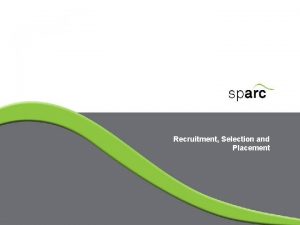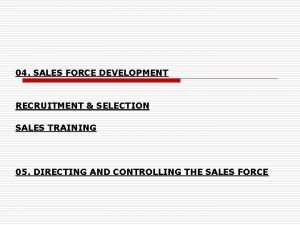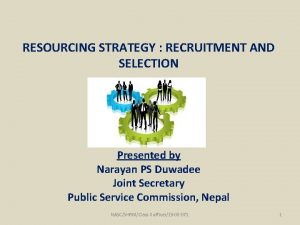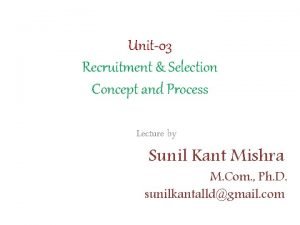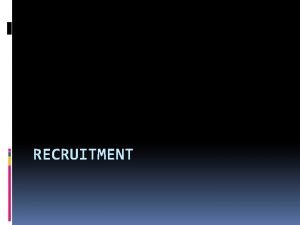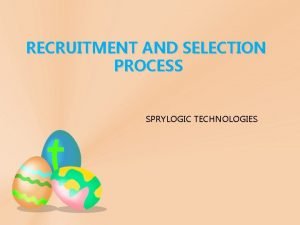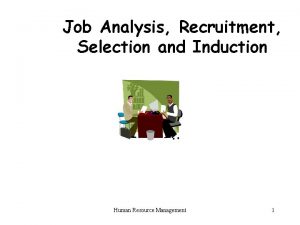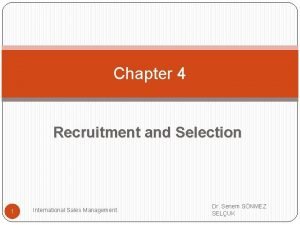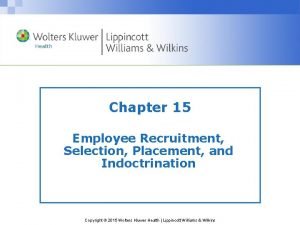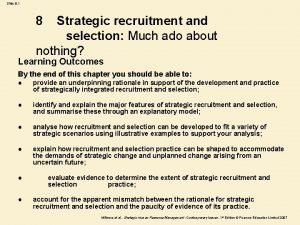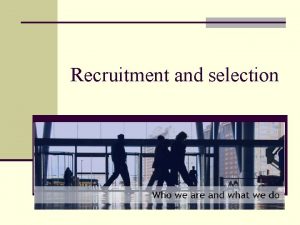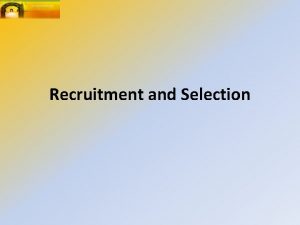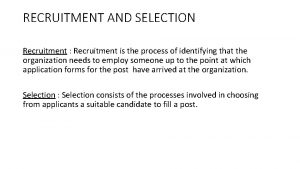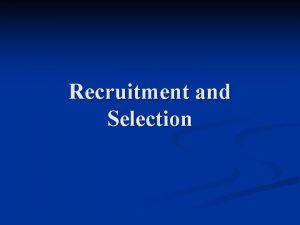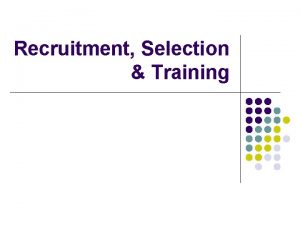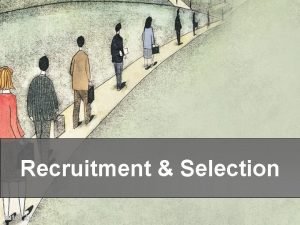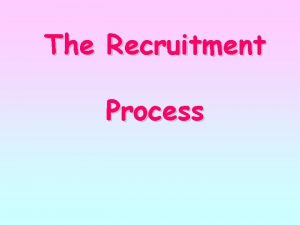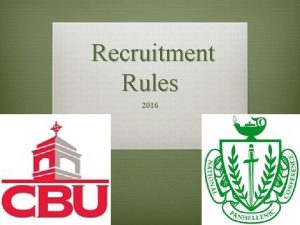The Recruitment and Selection Process Stage 1 Recruitment














- Slides: 14

The Recruitment and Selection Process Stage 1 Recruitment New work Existing work not being completed Staff replacement Analyse the job and competencies Is there a vacancy? Yes Describe the job - job description Describe the person to do the job - person specification

The Recruitment and Selection Process Stage 1 Recruitment Define the employment terms and conditions (inc. salary level/grade) Is the new job/replacement authorised? Yes - by CEO or senior manager Who are the target groups of candidates? Internal External Consider alternative methods of attracting a field of candidates

The Recruitment and Selection Process Stage 1 Recruitment Decide with HR how the vacancy will be advertised Draft the job advertisement and agree Log all enquiries and applications Organise selection programme - who will be involved in shortlisting, testing and interviewing? , dates, interview briefing etc.

The Recruitment and Selection Process Stage 2 Selection Shortlist applicants against person specification Possible Unsuitable Reject Make reception arrangements and invite candidates to: Test (if appropriate) Interview

The Recruitment and Selection Process Stage 2 Selection Review selection data (interview notes, test results, qualifications, references etc. ) and assess against person specification Select and rank suitable candidates Unsuitable Reject Confirm suitable references have been received Make offer (subject to medical) Suitable Unsuitable Reject

The Recruitment and Selection Process Stage 2 Selection Confirm offer Candidate accepts Explain joining instructions Make induction arrangements Candidate rejects Call in reserve candidates Re-start the recruitment and selection procedure Evaluate effectiveness of the recruitment and selection project

Step 6 - Shortlisting • The essential criteria are agreed in consultation with interviewer/panel members from the person specification • Application forms are sifted and key points are compared with the person specification on an individual basis • The shortlisting process is objective, focusing upon the positive aspects, rather than the negative • Care is needed to avoid personal bias • The selector discusses their shortlist with other panel members and agreement is reached

Selection techniques application form CVs covering letter telephone screening references/recommendations graphology biographical data psychometric testing (e. g. skills, aptitude and/or personality) • assessment centres • interview • •

Selection techniques The Selection Interview The interview is the most popular selection method and is described as: “a controlled conversation with a purpose” Torrington 1995

Selection techniques The Selection Interview The purposes are as follows: • To collect data to determine how successfully the individual would perform in the job for which they have applied, by measuring them against pre-determined criteria • To provide the candidate with full details of the job and the organization to facilitate their decision making • To conduct the interview in such a way that candidates feel they have been given an objective and fair hearing

Selection techniques The Selection Interview Webster (1964) concludes that • Interviewers decide to accept or reject a candidate within the first three minutes of the interview and spend the remainder of the time seeking evidence to confirm their first impression. • Interviews seldom alter the tentative opinion formed by the interviewer seeing the application form and the appearance of the candidate. • Interviewers place more weight on evidence that is unfavourable than evidence that is favourable.

Selection techniques The Selection Interview – Structure • Put the candidate at ease • Ask questions to elicit useful data against the selection criteria • Give the candidate information about the organisation • Do not give any signals about performance or make any commitment to selection choice • Close the interview by giving an indication about next steps

Selection techniques The Selection Interview – Questioning Techniques Strategies: • Situational or Behavioural interviewing Questions • Easy, relaxing questions (cliched or personal questions) • Open or closed questions • Leading or multiple questions • Probing

Evaluation of recruitment and selection Consider how you could effectively evaluate the recruitment and selection process.
 Recruitment and selection course outline
Recruitment and selection course outline Recruitment and selection of sales force
Recruitment and selection of sales force Recruitment selection and induction
Recruitment selection and induction Recruitment and selection process flowchart
Recruitment and selection process flowchart Talent aquisition meaning
Talent aquisition meaning What is recruitment
What is recruitment It staffing process
It staffing process Recruitment and selection definition
Recruitment and selection definition Difference between recruitment and hiring
Difference between recruitment and hiring Slidetodoc.com
Slidetodoc.com Job analysis recruitment and selection
Job analysis recruitment and selection Human resource management exam questions
Human resource management exam questions Recruitment and selection of sales personnel
Recruitment and selection of sales personnel Recruitment selection and placement
Recruitment selection and placement Strategic recruitment and selection
Strategic recruitment and selection
